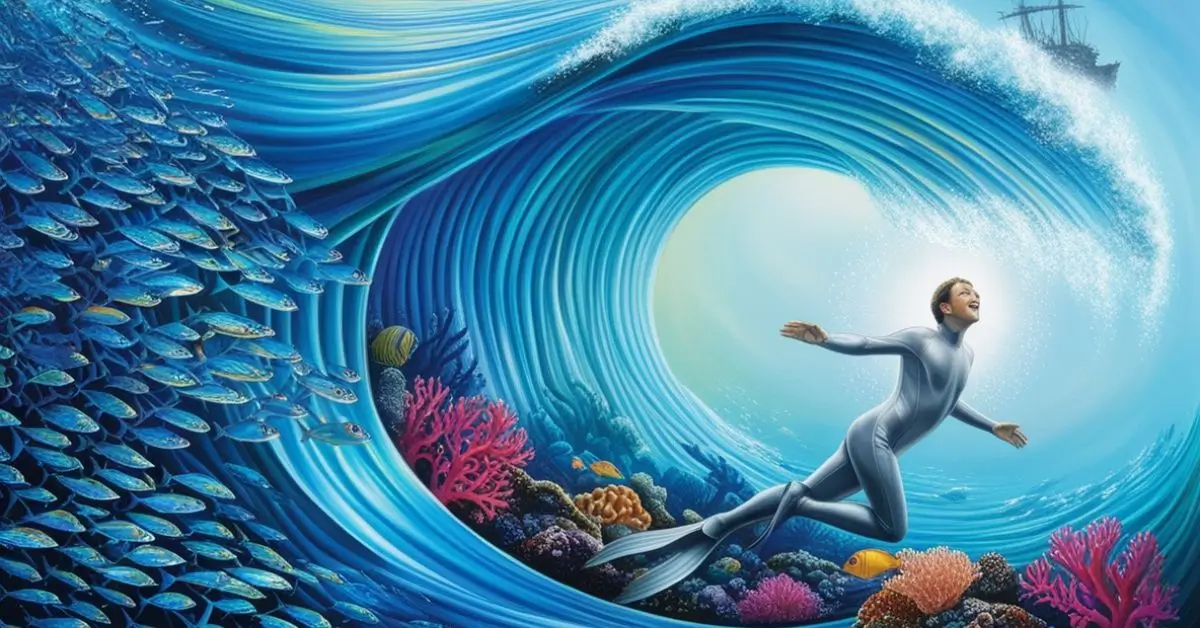The phrase “Sea of Blue” evokes images of endless horizons, calm waves, and the serene color that covers nearly three-quarters of our planet. But beyond the literal ocean, the idea of a “Sea of Blue” encompasses symbolism in art, expressions of solidarity, and calls to protect our vast marine ecosystems. This article takes you on a journey through the physical and metaphorical meanings of the “Sea of Blue,” unraveling the ways it impacts our lives, our imagination, and our natural environment.
The Symbolism of Blue in Various Cultures
In many cultures, the color blue has long held powerful meanings. Representing the sky and the sea, it’s often associated with depth, stability, peace, and calm. Historically, blue has symbolized everything from the infinite sky to the divine.
- Ancient Egypt: Egyptians prized the color blue, linking it to the heavens, the Nile, and rebirth. Lapis lazuli, a deep blue stone, was considered sacred and was commonly used in art, jewelry, and even in the burial masks of pharaohs.
- India and Hinduism: In Hindu culture, blue symbolizes the god Krishna, who embodies love, compassion, and divine joy. This connection with spirituality further highlights the peace and depth associated with the color blue.
- Japan: Japanese culture often connects blue to resilience and strength, a color that resonates with nature, particularly the sea and the skies of the island nation. It represents calm and stability, akin to a state of quiet meditation.
Throughout the world, blue has also come to represent trust, loyalty, and wisdom, becoming the universal color for corporate branding, uniforms, and even law enforcement. In sum, blue is not only a color but a symbol of values that connect humans across generations and geographies.
The Ocean as a ‘Sea of Blue’
The ocean is a true “Sea of Blue” in every sense. Oceans appear blue because water absorbs colors in the red part of the light spectrum, while the shorter blue wavelengths are scattered, reflecting the rich shades of blue that our eyes perceive.
But the “Sea of Blue” goes beyond aesthetics. The ocean is a vast ecosystem filled with diverse marine life, each layer of its depths revealing different shades of blue and unique ecosystems. Near the surface, light reaches coral reefs, illuminating vibrant fish and marine vegetation. As we go deeper, shades darken, and sunlight fades, creating a mysterious blue twilight zone where creatures have evolved remarkable adaptations for survival.
In essence, the ocean’s blue hue is more than just a visual delight; it’s an indicator of water quality and health. Oceanographers use this color information to study the presence of plankton, algae, and other microorganisms. Scientists can determine ocean health by studying these changes in color, which can be impacted by pollution, climate change, and temperature shifts.
“Sea of Blue” in Literature and Art
Throughout art and literature, the “Sea of Blue” has been a powerful metaphor. The image of endless blue is used to evoke emotions ranging from tranquility and freedom to mystery and melancholy.
- Poetry: Many poets describe the sea as blue to symbolize peace or introspection. Romantic poets like William Wordsworth and Samuel Taylor Coleridge often used the sea to explore human emotion and nature’s power. The “Sea of Blue” becomes a canvas on which feelings of love, sadness, or hope are painted.
- Visual Arts: Artists like Claude Monet and Vincent van Gogh captured the vastness of the sea, emphasizing the contrast of blues with light to evoke emotion. Monet’s impressionistic views of water lilies and seascapes are studies in blue, highlighting its reflective and serene qualities.
In both literature and art, the “Sea of Blue” is more than a color; it is a symbol of human introspection and our relationship with nature. Artists and writers use blue as a means to explore themes of freedom, loss, and the infinite.
The Concept of a ‘Sea of Blue’ in Modern Politics and Movements
The term “Sea of Blue” has also taken on symbolic meanings in political and social contexts, especially in movements around law enforcement and public unity. When people gather to support law enforcement, blue is often the color of choice, symbolizing strength, unity, and support.
In countries like the United States, “Sea of Blue” can refer to large gatherings of law enforcement officers or supporters during events like memorials for fallen officers. These gatherings display solidarity and respect, honoring those who protect and serve. However, the symbolism of blue can also carry complex meanings depending on perspectives and experiences with law enforcement, leading to varied interpretations.
Beyond law enforcement, blue ribbons and other symbols have been adopted to represent causes such as child abuse prevention, autism awareness, and anti-bullying campaigns. In these instances, blue again becomes a unifying color, resonating as a symbol of hope, healing, and resilience.
Marine Life in the Blue Depths
Beneath the ocean’s blue surface lies a world filled with life, from coral reefs to the mysterious creatures of the deep sea. Marine life has adapted uniquely to the different blue layers of the ocean.
- Shallow Zones: In areas where sunlight can penetrate, photosynthesis is possible. Coral reefs, often called “rainforests of the sea,” support vast biodiversity, including colorful fish, mollusks, and plants.
- Deep Sea and Twilight Zones: As we descend, light becomes scarce, and blue shades darken. Here, species have evolved bioluminescence to survive. Anglerfish, giant squid, and various jellyfish thrive in the dark, employing unique methods to attract mates or prey.
The “Sea of Blue” is not just an aesthetic feature of the earth but a dynamic ecosystem where organisms live and interact in ways that continue to fascinate and challenge scientists. Studying these ecosystems is crucial for understanding biodiversity and the health of our planet.
Environmental Concerns Affecting the ‘Sea of Blue’
While the ocean remains beautiful, it faces several threats that endanger its “Sea of Blue.” Plastic pollution, climate change, and overfishing are some of the major issues threatening ocean health. Microplastics infiltrate marine food chains, harming both small and large creatures and eventually affecting human health as well.
Climate change has led to warmer sea temperatures, which cause coral bleaching and disrupt the natural balance of marine ecosystems. Overfishing, particularly in unregulated waters, also puts species at risk, threatening food security and biodiversity.
- Efforts in Conservation: Many organizations work tirelessly to protect the “Sea of Blue.” Initiatives like coral reef restoration, marine protected areas, and beach cleanups help reduce human impact. Additionally, international agreements aim to regulate fishing and pollution, striving to preserve marine ecosystems for future generations.
Protecting the “Sea of Blue” is essential not just for marine life but for the planet as a whole. Oceans are crucial in regulating climate and providing oxygen, making their conservation a global priority.
Travel and Tourism: Seeking the ‘Sea of Blue’
For travelers, the allure of the “Sea of Blue” is undeniable. Destinations known for their stunning blue waters, like the Maldives, Great Barrier Reef, and Caribbean islands, attract millions of tourists each year. The beauty of these waters offers a serene escape, but with tourism comes the responsibility to protect these delicate environments.
- Ecotourism and Responsible Travel: Tourists are increasingly choosing ecotourism, which emphasizes conservation and sustainable travel. Many destinations promote eco-friendly practices, encouraging tourists to minimize waste, respect local marine life, and support conservation efforts.
By promoting sustainable tourism, travelers can enjoy the “Sea of Blue” without harming the environment, ensuring these breathtaking places remain pristine for generations.
Conclusion:
The “Sea of Blue” is a phrase rich with meaning, stretching from the depths of the ocean to the human heart. It represents the beauty and mystery of the ocean, the unity and strength of communities, and the power of imagination in art and literature. However, it is also a reminder of our responsibility to protect and preserve the blue planet we call home.
By embracing sustainable practices and raising awareness of environmental issues, we can ensure that future generations will experience the wonder of a world covered in blue. Whether we see it as a symbol of peace, a rallying cry, or a call to conservation, the “Sea of Blue” will remain a timeless part of our global culture and natural heritage.











